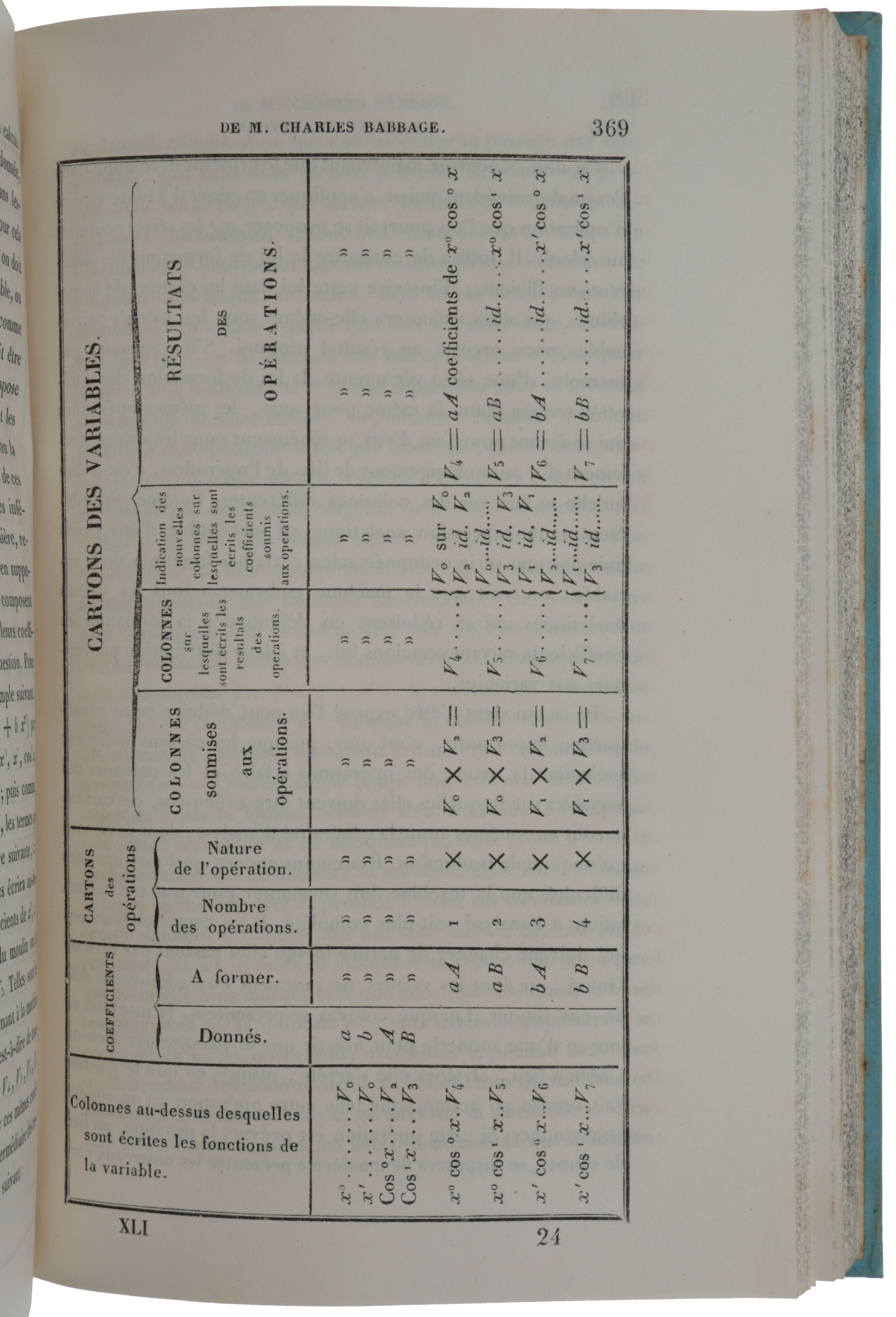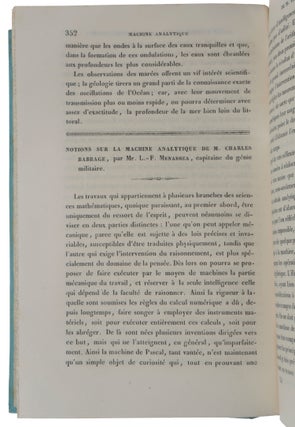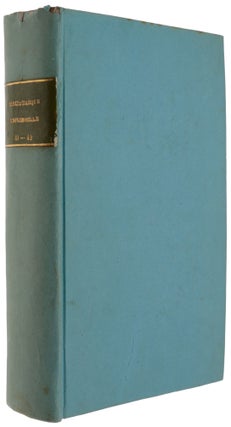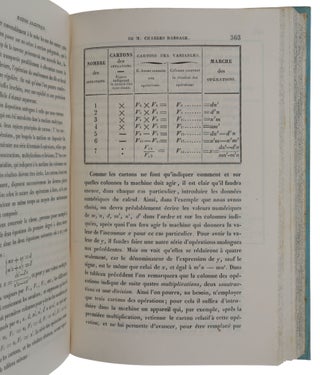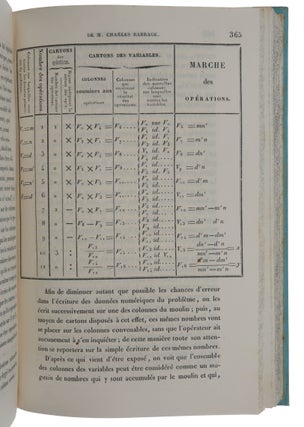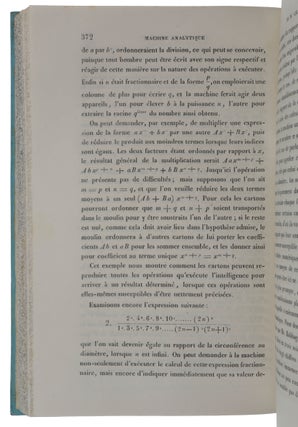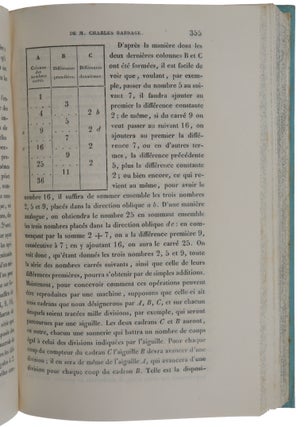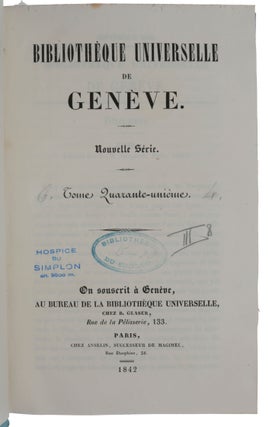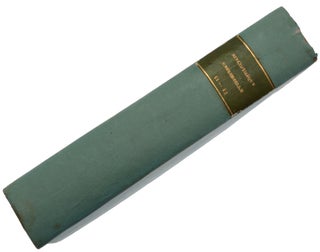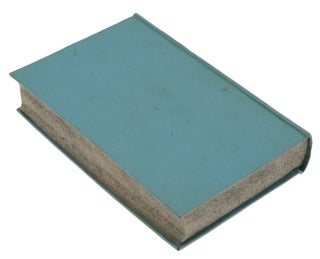‘Notions sur la machine analytique de M. Charles Babbage,’ pp. 352-376 in: Bibliothèque Universelle de Genève. Nouvelle Série, Tome 41.
Paris: Anselin, 1842. First edition, journal issue, of Menabrea’s account of the only public presentation that Babbage ever made concerning the design and operation of the Analytical Engine. “This was the first published account of Charles Babbage’s Analytical Engine and the first account of its logical design, including the first examples of computer programs ever published. As is well known, Babbage’s conception and design of his Analytical Engine—the first general purpose programmable digital computer—were so far ahead of the imagination of his mathematical and scientific colleagues that few expressed much curiosity regarding it. Babbage first conceived the Analytical Engine in 1834. This general-purpose mechanical machine—never completely constructed—embodied in its design most of the features of the general-purpose programmable digital computer. In its conception and design Babbage incorporated ideas and names from the textile industry, including data and program input, output, and storage on punched cards similar to those used in Jacquard looms, a central processing unit called the ‘mill,’ and memory called the ‘store.’ In 1840 Babbage traveled to Turin to make a presentation on the Analytical Engine. Babbage’s talk, complete with charts, drawings, models, and mechanical notations, emphasized the Engine’s signal feature: its ability to guide its own operations—what we call conditional branching. In attendance at Babbage’s lecture was the young Italian mathematician Luigi Federico Menabrea (1809-1896), who prepared from his notes an account of the principles of the Analytical Engine. Reflecting a lack of urgency regarding radical innovation unimaginable to us today, Menabrea did not get around to publishing his paper until two years after Babbage made his presentation, and when he did so he published it in French in a Swiss journal [offered here]. Shortly after Menabrea’s paper appeared Babbage was refused government funding for construction of the machine” (historyofinformation.com). “In keeping with the more general nature and immaterial status of the Analytical Engine, Menabrea’s account dealt little with mechanical details. Instead he described the functional organization and mathematical operation of this more flexible and powerful invention. To illustrate its capabilities, he presented several charts or tables of the steps through which the machine would be directed to go in performing calculations and finding numerical solutions to algebraic equations. These steps were the instructions the engine’s operator would punch in coded form on cards to be fed into the machine; hence, the charts constituted the first computer programs [emphasis ours]. Menabrea’s charts were taken from those Babbage brought to Torino to illustrate his talks there” (Stein, Ada: A Life and a Legacy, p. 92). ABPC/RBH list only the OOC copy (Christie’s, 2005). In 1828, during his grand tour of Europe, Babbage had suggested a meeting of Italian scientists to the Grand Duke of Tuscany. On his return to England Babbage corresponded with the Duke, sending specimens of British manufactures and receiving on one occasion from the Duke a thermometer from the time of Galileo. In 1839 Babbage was invited to attend a meeting of Italian scientists at Pisa, but he was not ready and declined. “In 1840 a similar meeting was arranged in Turin. By then Babbage did feel ready, and accepted the invitation from [Giovanni] Plana (1781-1864) to present the Analytical Engine before the assembled philosophers of Italy … In the middle of August 1840, Babbage left England … “Babbage had persuaded his friend Professor MacCullagh of Dublin to abandon a climbing trip in the Tyrol to join him at the Turin meeting. There in Babbage’s apartments for several mornings Babbage met Plana, Menabrea, Mosotti, MacCullagh, Plantamour, and other mathematicians and engineers of Italy. Babbage had taken with him drawings, models and sheets of his mechanical notations to help explain the principles and mode of operation of the Analytical Engine. The discussions in Turin were the only public presentation before a group of competent scientists during Babbage’s lifetime of those extraordinary forebears of the modern digital computer. It is an eternal disgrace that no comparable opportunity was ever offered to Babbage in his own country … “The problems of understanding the principles of the Analytical Engines were by no means straightforward even for the assembly of formidable scientific talents which gathered in Babbage’s apartments in Turin. The difficulty lay not as much in detail but rather in the basic concepts. Those men would certainly have been familiar with the use of punched cards in the Jacquard loom, and it may reasonably be assumed that the models would have been sufficient to explain the mechanical operation in so far as Babbage deemed necessary. Mosotti, for example, admitted the power of the mechanism to handle the relations of arithmetic, and even of algebraic relations, but he had great difficulty in comprehending how a machine could handle general conditional operations: that is to say what the machine does if its course of action must be determined by results arising from its own previous calculations. By a series of particular examples, Babbage gradually led his audience to understand and accept the general principles of his engine. In particular, he explained how the machine could, as a result of its own calculations, advance or back the operation cards, which controlled the sequence of operations of the Engine, by any required number of steps. This was perhaps the crucial point: only one example of conditional operations within the Engine, it was a big step in the direction of the stored program, so familiar today to the tens of millions of people who use electronic computers. “In explaining the Engines Babbage was forced to put his thoughts into ordinary language; and, as discussion proceeded his own ideas crystallized and developed. At first Plana had intended to make notes of the discussions so that he could prepare a description of the principles of the Engines. But Plana was old, his letters of the time are in a shaky hand, and the task fell upon a young mathematician called Menabrea, later to be Prime Minister of the newly united Italy. It is interesting to reflect that no one remotely approaching Menabrea in scientific competence has ever been Prime Minister of Britain … “Babbage’s primary object in attending the Turin meeting had been to secure understanding and recognition for the Analytical Engine. He hoped that Plana would make a brief formal report on the Engine to the Academy of Turin and that Menabrea would soon complete his article. Babbage sent him further explanations to complement the notes he had made during Babbage’s exposition and the discussions in Turin. Babbage had certainly little hope of government comprehension or support in England but he was determined not to miss the slightest opportunity of securing recognition for his Engines. “He set down his own thoughts in a letter written at about this time to Angelo Sismoda, whom he had often seen during the Turin meeting: ‘The discovery of the Analytical Engine is so much in advance of my own country, and I fear even of the age, that it is very important for its success that the fact should not rest upon my unsupported testimony. I therefore selected the meeting at Turin as the time of its publication, partly from the celebrity of its academy and partly from my high estimation of Plana, and I hoped that a report on the principles on which it is formed would have been already made to the Royal Academy.’ But Plana was old and ill: no report was forthcoming … “Babbage returned from the sunny hills and valleys of Tuscany where he had basked in Ducal warmth and the approbation of philosophers to a chilly climate in England. He sent further explanations to Menabrea who in turn entirely rewrote the article. On 27 January 1842 Menabrea wrote to Babbage from Turin: ‘Je donnerai la dernière main a l’écrit qui vous concerne et j’espère dans quelques jours l’envoyer a Genève au bureau de la Bibliothèque Universelle.’ In number 82 of October 1842 the article finally appeared” (Hyman, Charles Babbage (1982), pp. 181-190). “Menabrea’s 23-page paper was translated into English the following year by Lord Byron’s daughter, Augusta Ada King, Countess of Lovelace, daughter of Lord Byron, who, in collaboration with Babbage, added a series of lengthy notes enlarging on the intended design and operation of Babbage’s machine. Menabrea’s paper and Ada Lovelace’s translation represent the only detailed publications on the Analytical Engine before Babbage’s account in his autobiography (1864). Menabrea himself wrote only two other very brief articles about the Analytical Engine in 1855, primarily concerning his gratification that Countess Lovelace had translated his paper” (historyofinformation.com). Hook & Norman, Origins of Cyberspace (2002), No. 60.
8vo, pp. [5], 6-420, with folding table and plate, several tables printed within text. Bound with Tome 42 in contemporary pale blue boards, leather lettering-piece on spine (chipped at head of spine, two old institutional stamps and pencil marks on title).
Item #5187
Price: $32,500.00

